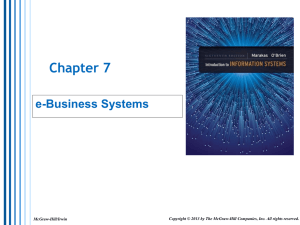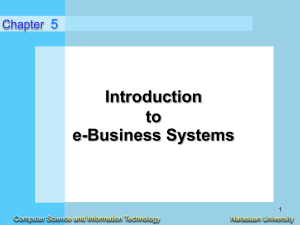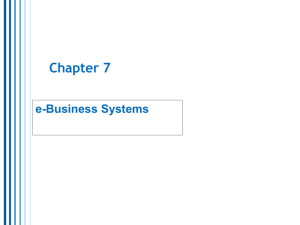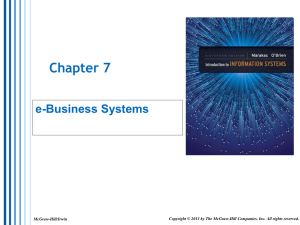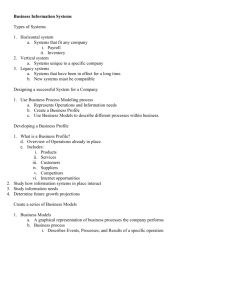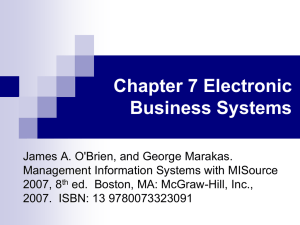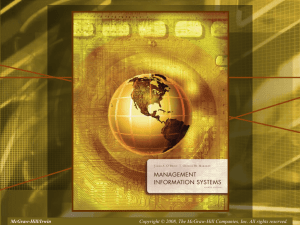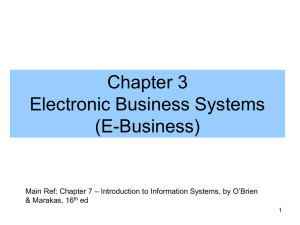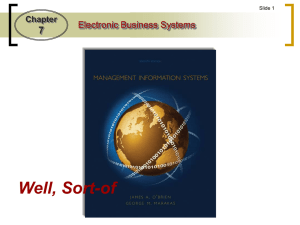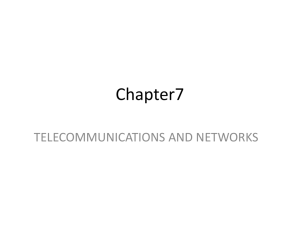Chapter 5
advertisement
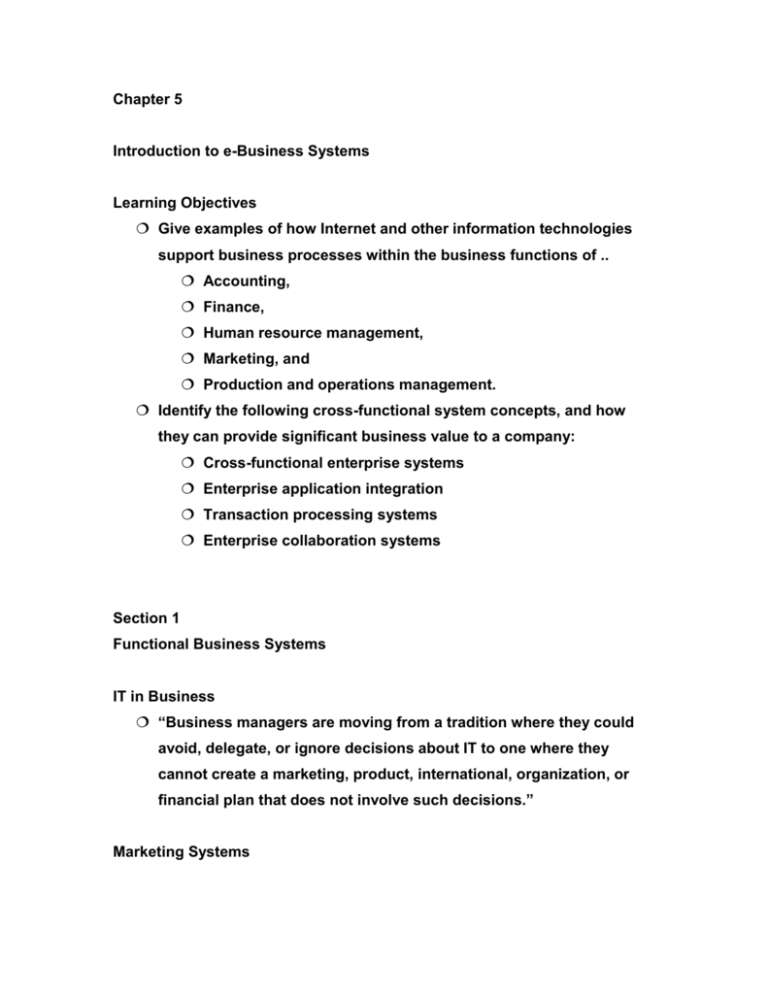
Chapter 5 Introduction to e-Business Systems Learning Objectives Give examples of how Internet and other information technologies support business processes within the business functions of .. Accounting, Finance, Human resource management, Marketing, and Production and operations management. Identify the following cross-functional system concepts, and how they can provide significant business value to a company: Cross-functional enterprise systems Enterprise application integration Transaction processing systems Enterprise collaboration systems Section 1 Functional Business Systems IT in Business “Business managers are moving from a tradition where they could avoid, delegate, or ignore decisions about IT to one where they cannot create a marketing, product, international, organization, or financial plan that does not involve such decisions.” Marketing Systems Marketing Information Systems provide information technologies that support major components of the marketing function. Interactive Marketing Customer focused marketing process Based on using Internet, intranets, & extranets to establish two-way communications between customers or potential customers and the business Customers become involved in product development, delivery, & service issues Targeted marketing Five targeting components Community Content Context Demographic/psychographic Online behavior Sales Force Automation The sales force is connected to marketing websites on the Internet, extranets, & the company intranet Increases productivity of sales force Speeds up the capture & analysis of sales data Allows management to provide improved delivery information & better support of the sales force. Manufacturing Systems Support the production/operations function Assists firms in planning, monitoring, & controlling inventories, purchases, & the flow of goods and services Computer-Integrated Manufacturing (CIM) Simplify Automate Integrate Supports the concepts of flexible manufacturing systems, agile manufacturing, & total quality management Computer-Aided Engineering (CAE) Computer-Aided Design (CAD) Material Requirements Planning (MRP) Computer-Aided Manufacturing (CAM) Automate the production process Manufacturing Execution Systems (MES) Performance monitoring systems for factory floor operations Process Control The use of computers to control an ongoing physical process Machine Control The use of a computer to control the actions of a machine. Also called numerical control Human Resource Systems Human Resource Information Systems Support Planning to meet the personnel needs of the business Development of employees to their full potential Recruitment, selection, & hiring Job placement Performance appraisals Employee benefits analysis Training and development Health, safety, & security HRM and the Internet Allows companies to process most common HRM applications over their intranets. Allows companies to provide around-the-clock services to their employees. Allows companies to disseminate valuable information faster. Allows employees to perform HRM tasks online. Staffing Supported by information systems that record and track human resources to maximize their use Training and Development Help human resource managers plan and monitor employee recruitment, training, and development programs Accounting Systems Record and report business transactions and other economic events Online Accounting Systems Six widely used accounting systems Order processing Captures & processes customer orders and produces data needed for sales analysis and inventory control Inventory Control Processes data reflecting changes in items in inventory. Helps provide high-quality service while minimizing investment in inventory & inventory carrying costs Accounts Receivable Keeps records of amounts owed by customers from data generated by customer purchases and payments Accounts Payable Keeps track of data concerning purchases from, and payments to, suppliers Payroll Receives and maintains data from employee time cards and other work records General Ledger Consolidates data received from accounts receivable, accounts payable, payroll, & other accounting information systems Financial Management Systems Supports financial managers in decisions concerning The financing of the business The allocation & control of financial resources within the business. Major financial management system categories Cash Management Collects information on all cash receipts and disbursements on a real-time or periodic basis Investment Management Helps the financial manager make buy, sell, or hold decisions for each type of security Helps the financial manager develop the optimum mix of securities in order to minimize risk and maximize return Capital Budgeting Involves evaluating the profitability and financial impact of proposed capital expenditures Allows financial managers to analyze long-term expenditure proposals for plant and equipment Financial Forecasting & Planning Evaluate the present and projected financial performance of the company Help determine financing needs and analyze alternative methods of financing Explore what-if and goal-seeking questions Section 2 Cross-Functional Enterprise Systems Cross-Functional Enterprise Applications Integrated combinations of information subsystems that share information resources and support business processes across the functional units A strategic way to use IT to share information resources & improve efficiency & effectiveness Enterprise Application Architecture Focused on accomplishing fundamental business processes in concert with the company’s customer, supplier, partner, & employee stakeholders Enterprise Application Integration (EAI) Software enables users to model the business processes involved in the interactions that should occur between business applications. Also provides middleware that Performs data conversion & coordination Provides application communication & messaging services Provides access to the application interfaces Business value Integrates front-office and back-office applications to allow for quicker, more effective response to business events and customer demands Improves customer and suppler experience with the business because of its responsiveness. Transaction Processing Systems Cross-functional information systems that process data resulting from the occurrence of business transactions Transactions – events that occur as part of doing business Sales Purchases Deposits Withdrawals Refunds Payments Online transaction processing systems Real-time systems that capture and process transactions immediately Adds value to product or service through superior customer service Transaction Processing Cycle Data entry The capture of business data Transaction processing Two basic ways Batch processing where transaction data are accumulated & processed periodically Real-time processing where data are processed immediately after a transaction occurs Database maintenance Corporate databases are updated to reflect the day-today business transactions Document and report generation A variety of documents and reports are produced Inquiry processing Inquiries and responses concerning the results of transaction processing activity Enterprise Collaboration Systems Cross-functional e-business systems that enhance communication, coordination, & collaboration Communicate – share information with each other Coordinate – coordinate individual work efforts & use of resources with each other. Collaborate – work together cooperatively on joint projects and assignments Tools for Enterprise Collaboration Electronic communication E-mail Voice mail Fax Web publishing Bulletin boards Paging Internet phone systems Electronic conferencing Data & voice conferencing Videoconferencing Chat systems Discussion forums Electronic meeting systems Synchronous. Team members can meet at the same time and place in a “decision room” setting Collaborative work management Calendaring & scheduling Task & project management Workflow systems Knowledge management
